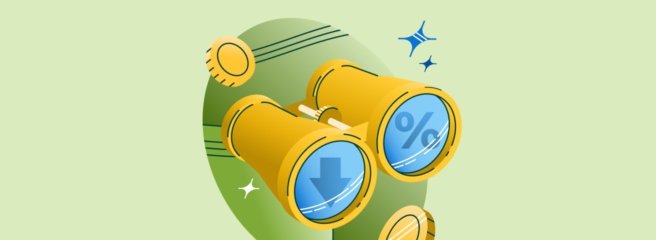
Let’s be honest: the home-buying process isn’t easy. From scoping out homes to vetting real estate agents to making an offer, it can be a 24/7 experience that requires a lot of financial planning.
Even after you find the perfect home, you still have to pay for it. For many prospective homeowners, coming up with enough money to make a down payment on a house can feel challenging. Luckily, you’ve got options.
In this guide, we’ll discuss the ins and outs of house down payments. We’ll explain how to calculate a down payment and the pros and cons of making a larger down payment. We’ll also discuss how much you need to put down on a house and the best ways to fund your down payment.
What is a down payment?
A down payment is the money you pay upfront when you buy something expensive, like a car or house. Typically, a down payment is a percentage of the total cost and represents your initial stake—or ownership—in the property.
You usually pay the down payment out-of-pocket and use a loan from a bank or lending company to finance the rest of the balance. Then, you make monthly payments on the loan principal and interest. Once you pay off your loan, you’ll own the property free and clear.
How much should you put down on a house?
You’ve probably heard you need to put 20% down to get your dream home. But, that’s not entirely true. In 2021, the average down payment on a house was 12%. What’s more, 45% of home buyers put down 10% or less on their homes.
With that said, it’s clear the typical down payment on a house is less than 20%. Lenders simply use the 20% number to determine if a borrower needs private mortgage insurance (PMI) for their loan.
What is PMI?
PMI insurance is a type of loan insurance some lenders require when borrowers make a down payment of 19.99% or less. Essentially, PMI helps protect your mortgage lender in case you are unable to pay your mortgage.
Your PMI insurance costs are usually built into your loan. Generally, you only need to pay for PMI until you reach 20% equity in your home.
Consider this example: You plan to buy a $300,000 home and put 10% down, so you’ll need to purchase PMI. Once you’ve paid 20% of the total cost of your home—$60,000—your lender will no longer require PMI. They may even cancel the insurance automatically once you reach the 20% benchmark.
PMI usually costs between 0.5% to 1% of your loan each year. With that in mind, it would be more cost-effective to make a slightly larger down payment and avoid the extra costs of PMI when possible.
Minimum down payment requirements
How much do you have to put down on a house? Potentially, you could put down nothing upfront and finance 100% of your home’s purchase price with a loan. It may sound tempting, especially if you don’t plan to live in your home for very long.
However, putting the minimum down on a house could impact the types of loan you qualify for. For instance, a conventional loan down payment is usually higher than those required by a government-backed mortgage.
Depending on your down payment amount, you may only be able to get a loan for a home in certain areas.
Still not sure how much to put down on a house? Consider the following low-down-payment options available to qualifying borrowers:
- 0% down: In some cases, you may be able to buy a house with no down payment. You have two options when it comes to 0% down mortgages: Department of Veterans Affairs (VA) loans or U.S. Department of Agriculture Rural Development Program (USDA) loans.VA loans are only available for current or former military service members and some surviving spouses.USDA loans come with somewhat strict requirements. These no-down-payment loans are only available to qualifying home buyers in rural or suburban areas.
- 3% to 3.5% down: Some conventional and government-backed loans, such as HomeReady loans or Federal Housing Administration (FHA) loans, require as little as 3% to 3.5% down.FHA down payment requirements are usually less stringent than conventional loans, because they’re backed by the government. To qualify for an FHA loan with a 3% down payment, you’ll need a credit score of 580 or higher. You’ll also need to purchase PMI, provide proof of income and employment, and have a debt-to-income ratio of 43% or lower.
- 10% down: If your credit score falls below 580, you still have an option. The FHA offers home loans with 10% down payments to borrowers with a credit score of 500 or higher.You must satisfy the other guidelines we mentioned above. Still, these loans make it easier to save on your down payment and start building equity in your home.
Is it worth putting 20% down on a house?
Making a larger down payment upfront can help you save money in the long run. But, there’s no denying that saving up for a costly down payment takes time. The idea of cutting back on expenses and building up your cash reserves may not sound appealing if you’re ready to move now.
On the other hand, you may not have another option. Many circumstances could force you to move long before you save 20%. And that’s okay. There’s no “right” way to go about buying a home.
With that said, consider these pros and cons of putting 20% down on a house.
Pros of a 20% down payment
- You’ll instantly have more equity in your home.
- Your monthly mortgage payment will likely be lower.
- You may qualify for a more affordable interest rate.
- You may pay fewer fees upfront and on a monthly basis.
- You’ll avoid PMI charges.
- Your offer may be more appealing to sellers.
Cons of a 20% down payment
- You may not be able to buy a home for years while saving.
- You may not have enough available cash leftover to take on home repairs or renovations.
- You may not experience the long-term benefits of a large down payment if you only plan to live in the home for a short time.
- Saving for a down payment could take away from other savings goals, like retirement or college funds.
How to calculate a house down payment
You can calculate the cost of a house down payment in a few easy steps. First, determine the purchase price of the home. Then, decide what percentage of the price you can afford to put down. Multiply the total cost by the percentage to calculate the down payment.
As an example, consider the following. You plan to buy a $300,000 home and put down 3.5%. Insert the numbers into the equation to determine your out-of-pocket costs.
Down Payment = Purchase Price x Down Payment Percentage
Down Payment = $300,000 x 3.5%
Down Payment = $10,500
Remember, you’ll also need to pay other costs, like closing costs, loan origination fees, and insurance. These charges may vary, but you can usually expect to pay about 3% of the total purchase price in closing fees.
How to get enough money for a down payment on a house
No matter how much you decide to put down on your home, coming up with enough cash can be a stumbling block. You already have to cover your living expenses, bills, and healthcare. Even a small down payment could drain your savings and leave you in a difficult financial situation.
Don’t give up on your home search yet. Instead, consider these common strategies for overcoming your down payment dilemma:
- Apply for down payment assistance programs. Depending on your location and income, you may qualify for down payment assistance programs. Your state usually initiates these programs, but local government bodies, nonprofit organizations, or even employers may back them, too.These programs may offer grants or zero-interest loans to help you make a down payment. Some loan programs target specific cities or neighborhoods, while others help home buyers across the country. In many cases, a down payment assistance program can also help you get a more affordable mortgage or save with tax breaks.
- Save for a down payment. We know it’s not always possible to save money for your entire down payment. However, it doesn’t hurt to contribute some cash to your upfront costs.Reducing your total loan amount by even a few hundred dollars will lower your loan-to-value ratio (LTV). LTV measures the amount you borrowed compared to the total appraised value of your home. A lower LTV represents less risk to a lending company, which means you might qualify for a more affordable loan with a lower interest rate.
- Borrow from your retirement account. Generally, you should avoid borrowing from your retirement account at all costs. Doing so can impact your savings goals and delay your retirement plans. But, you may consider tapping into your savings if you’ve exhausted all other options.Keep in mind that retirement account withdrawals and loans have different guidelines based on the type of account you have and your age. If you borrow from your employer-sponsored 401(k) and are under age 59½, you may face steep interest charges and a short repayment period. Plus, you may have to pay extra taxes and a penalty on the loan if you leave your job before completing the repayment process.
Alternatively, traditional IRAs allow first-time homebuyers to borrow up to $10,000 with no penalties. You will pay income taxes on the money, though.
Finally, Roth IRAs offer slightly more flexibility for first-time buyer down payments. You can withdraw the money tax- and penalty-free as long as you’ve had the account for five years or more.
- Consider using a personal loan for your down payment. Some conventional and government-backed lenders won’t allow you to use a personal loan for the down payment on a house. If you opt for a lender that will allow it, a personal loan could help you cover your down payment without draining your savings account.A personal loan is a type of unsecured installment loan. After you get approved for a personal loan, you can use the funds for your down payment. Then, you’ll make fixed monthly payments until you’ve repaid the money you borrowed, plus interest.You usually need a good to excellent credit score to qualify for an affordable personal loan with a low interest rate, but that’s not always the case. At Upstart, our model considers non-traditional factors such as employment and education.* These factors may help you qualify for a loan that works for your budget.
So, how much money do you need to buy a house? It depends
After reading this guide, you’re likely more familiar with your options when it comes to making a house down payment. It’s important to remember that home-buying looks different for everyone, though.
Your financial circumstances and personal goals may allow you to put down as much as 20% upfront. Or, you may decide that putting down 10% or less is the better option. You may even choose to get an affordable personal loan through Upstart to cover your down payment or moving expenses. That way, you can use your savings for home repairs, relocation, or other costs.
No matter how you move forward, you can count on one thing: Sooner or later, you’ll get to start building equity in the home of your dreams.







 Won't affect your credit score¹
Won't affect your credit score¹